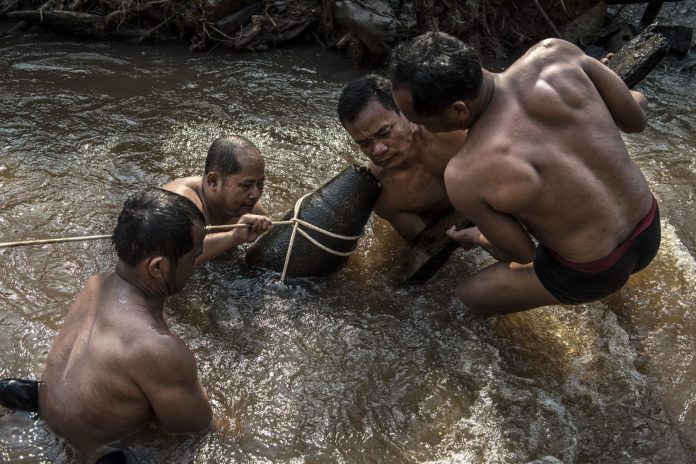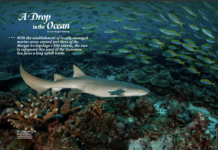
Cambodia’s first UXO dive team starts to make rivers safe
Text Robert Carmichael
Photos Charles Fox
Kandal Province. Sok Chenda had a lot going for him when he volunteered for a tough, two-year course, training to remove bombs and unexploded ordinance (UXO) from Cambodia’s rivers. For a start, the 38-year-old had spent nearly two decades at the Cambodian Mine Action Centre (CMAC), the government’s demining organisation, first as a deminer, then as a researcher, and finally, as a technical instructor and UXO team leader. Partly by nature and partly by training, Chenda is cautious and patient, a “safety-first” person.
But for someone looking to transfer those skills underwater, Chenda was missing one key element: he couldn’t swim much at all. He wasn’t alone. None of the 40 men (no women applied) who signed up in 2013 for the gruelling course run by ex-US Navy divers knew how to swim.
That was just one of their many learning curves. Another was how to operate in a zero-visibility environment, known by divers as “black water”. That is because the Mekong River, which carves a roughly north-to-south path through eastern Cambodia on its route to the South China Sea, carries so much silt that a diver can’t see their hand in front of their face.
“So at first, we wore blacked-out masks and learned how to identify the different explosives on land,” says Chenda, a stocky man with an easy smile. “After that, we went underwater and used those same tactics that we’d learned on land.”
It gets more complicated still, because removing UXO from underwater is far more dangerous than its land-based equivalent, and it’s trickier still to raise UXO from rivers as opposed to the sea. Strong currents, the lack of visibility, river debris and boat traffic all conspire to heighten the risks.

Given the rigours of the role, the trainees had to pass a series of tough physical and mental tests. In the end, just nine made the grade. Chenda was one of them. In May, with Chenda as team leader, they carried out their first mission: recovering and making safe a 500-pound (227-kilogram) US-made Mark-82 bomb from the Mekong near the capital Phnom Penh.
Why volunteer for such dangerous work? Simple, Chenda replies, “It is very important for the sake of developing our country.”
History’s long, deadly reach
The Mark-82 bomb is part of Cambodia’s legacy of decades of conflict, from the US’s illegal bombing in the late 1960s and early 1970s, to the civil war that culminated in the 1975 victory of Pol Pot’s Khmer Rouge movement, whose four-year rule cost two million lives. After the Khmer Rouge were ousted in 1979, fighting continued for another 20 years.
Since 1979, landmines and UXO have killed nearly 20,000 people and injured more than 44,000. But the situation has improved markedly. As demining groups like Cambodian Mine Action Centre (CMAC), Mines Advisory Group (MAG), and The Halo Trust press on, clearing around 100 square kilometres of land each year, the annual toll has decreased. Last year, landmines and UXO killed 21 people and injured 136.
To date, this work has been done on land where, for example, CMAC has recovered 4,000 bombs. The advent of the dive team means it can now take this search underwater.
Under normal circumstances, a country would train a military dive unit to recover underwater UXO. This is the first time that a dive team tasked with humanitarian work like this has been trained from scratch.
The training, funded by the US State Department, was carried out by the Golden West Humanitarian Foundation, a US-based non-profit, which for more than a decade has helped demining and UXO efforts here. Watching the first mission from a nearby boat, country representative Allen Dodgson Tan tells ASIAN Geographic the team’s purpose is to focus on UXO that pose a risk.
“We’re not trying to clear the river of all the ordinance and explosives in there – it’s not possible,” says Tan, a former US Army bomb disposal expert. “There are probably hundreds of thousands of pieces of ordinance in Cambodian waterways, and they’re fine right where they are buried under lots of mud.”
Each time a bomb is called in, the team will assess the situation: “Is a fisherman getting his net caught in it? Is a boat going to hit it? Are they going to build something like a bridge where they need to clear an area for a pylon? Are they going to dredge there?” he explains. “These are the kinds of things we look at.”
Swords into ploughshares
And so, as the sun pushed higher and the palm trees’ shadows on the banks shortened, the team got to work. The recovery took less than an hour. First, diver Lorn Sarath dug away the mud surrounding the bomb’s nose. Then Chenda descended and attached the cables from an inflatable balloon to the bomb, which was still live.

Inflating the balloon jolted the bomb free, the most dangerous part of the operation. After that, the team towed it to the ferry crossing, then drove it – slowly – across rutted tracks to a nearby field. There, the Mark-82’s nose and tail were cut off, removing the two fuses and making it safe.
The bomb was then taken to a Golden West facility, where its 250 pounds (113 kilograms) of explosives was turned into 1,000 small charges. Deminers use those charges to blow up the landmines they uncover – a virtuous circle, says Golden West’s Tan, turning “weapons of war into tools of peace”.
What’s next? The team has located an ammunition barge sunk during the civil war and which CMAC reckons still contains its explosive cargo.
Over the years, says Tan, sunken ammunition barges were scavenged by illegal operators who sell the explosives on the black market – both a security risk and a public safety hazard.
“Previously, if this boat were to be discovered by the police, there would be no recourse… They had no one they could send down to deal with that,” he says. “Now, with our team, they do.”
For more stories and photos, check out Asian Geographic Issue 114.










